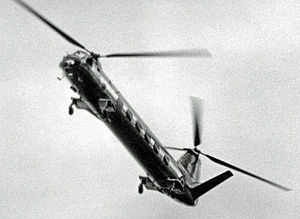Bristol Type 173
| Type 173 | |
|---|---|
 |
|
| Second prototype Bristol 173 demonstrating at the 1954 Farnborough Air Show | |
| Role | 13-seat passenger helicopter |
| Manufacturer | Bristol Aeroplane Company |
| Designer | Raoul Hafner |
| First flight | 3 January 1952 |
| Number built | 5 |
| Developed into | Bristol Belvedere |
The Bristol Type 173 was a British twin-engine, tandem rotor transport helicopter built by the Bristol Aeroplane Company. It was designed by Raoul Hafner as a civil transport helicopter but evoked interest from the military. It did not enter production but was developed into the Bristol Belvedere which was operated by the Royal Air Force from 1961 to 1969.
The Type 173 was a tandem rotor development of the earlier Type 171 Sycamore single-rotor helicopter. It used two units of the Sycamore's Leonides Major engine and rotor with a new fuselage. The rotor gearboxes were connected by a shaft which enabled one engine to drive both rotors if an engine failed.
The first Type 173 Mk 1 registered G-ALBN made its first hovering flight on 3 January 1952 but it tended to fly backwards. After landing from a second hovering flight ground resonance developed. Modifications to the aircraft to correct these failures delayed the first flight out of the hover, which occurred on 24 August 1952. During 1953 it was evaluated by the Royal Air Force (using serial number XF785) and also carried out sea trials for the Royal Navy on the aircraft carrier HMS Eagle. To overcome resonance in the fuselage it was later fitted with four-bladed rotors.
The second Type 173 was designated Type 173 Mk 2 and allocated military serial XH379, and had a revised landing gear, with castoring front wheels and fixed rear wheels. It was also fitted with small stub wings at the front and rear to improve the cruise speed, the stub wings being removed after a few flights when the helicopter was used for Naval trials, and an unswept tailplane was added. As a result of the trials the Royal Navy showed an interest in ordering the type for carrier duties. In August 1956 the second prototype was leased to British European Airways for evaluation. The Mk 2 aircraft was destroyed in an accident during an air show at Filton in September 1956. The helicopter crashed into the ground nose first while making the transition from hover to forward flight. The crew escaped unharmed but the aircraft was written off. After the crash the tailplane was salvaged from the Mk 2 and fitted to the Mk 1 to investigate the best configuration for stability.
...
Wikipedia
